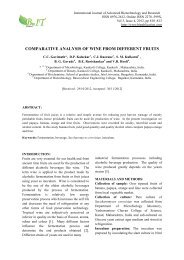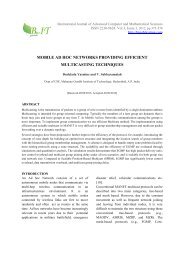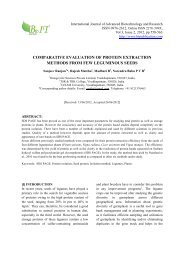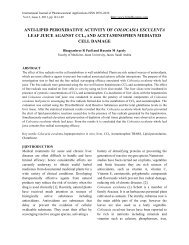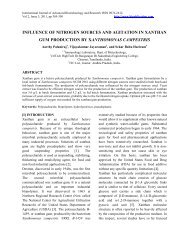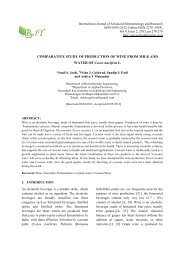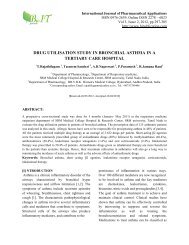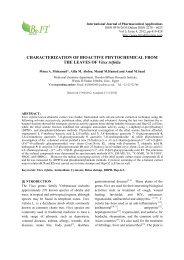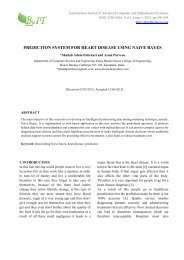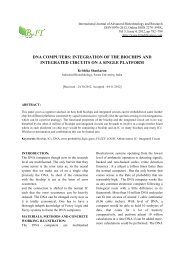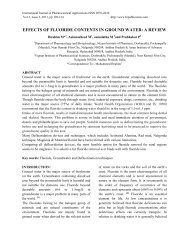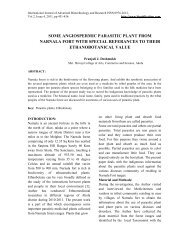anti-pyretic activity of ethanolic extract of merremia emarginata
anti-pyretic activity of ethanolic extract of merremia emarginata
anti-pyretic activity of ethanolic extract of merremia emarginata
Create successful ePaper yourself
Turn your PDF publications into a flip-book with our unique Google optimized e-Paper software.
International Journal <strong>of</strong> Pharmaceutical Applications ISSN 0976-2639.<br />
Vol 2, Issue 4, 2011, pp 258-261 http://www.bipublication.com<br />
ANTI-PYRETIC ACTIVITY OF ETHANOLIC EXTRACT OF MERREMIA<br />
EMARGINATA (BURM. F) HALLIER F. IN RAT<br />
Indumathy.S, Gausunnisha. T, Rajalakshmi .R, Roselin .A,<br />
Thamizharasy .P and Arul Anand Raj.C.A.<br />
Department <strong>of</strong> pharmacology, MTPG&RIHS, Puducherry. India<br />
Abstract:<br />
Pyrexia is the increase <strong>of</strong> body temperature than the normal due to metabolic disturbances. Anti<strong>pyretic</strong> drugs are widely used<br />
in the treatement <strong>of</strong> fever and pain. But the greatest disadvantage in presently available synthetic drugs is that they cause<br />
gastrointestinal irritation and reappearance <strong>of</strong> symptoms after discontinuation. Merremia <strong>emarginata</strong> (Burm. f) Hallier f.<br />
(Convolvulaceae) is a perennial, much branched herb. In the indigenous system <strong>of</strong> medicine, Merremia <strong>emarginata</strong> has been<br />
claimed to be useful for cough, headache, neuralgia, rheumatism, diuretic, treatment <strong>of</strong> inflammation, epilepsy, troubles <strong>of</strong><br />
nose etc. The <strong>ethanolic</strong> <strong>extract</strong> <strong>of</strong> the plant was prepared and screened for <strong>anti</strong><strong>pyretic</strong> <strong>activity</strong>. The acute toxicity studies also<br />
carried out. pyrexia was induced using cow’s milk 2ml/kg i.p.. The test drug M.<strong>emarginata</strong> at a dose <strong>of</strong> 200mg/kg i.p.<br />
possessed significant <strong>anti</strong><strong>pyretic</strong> <strong>activity</strong>. The <strong>activity</strong> was very comparable to standard drug paracetamol 150 mg/kg i.p.<br />
Keywords: pyrexia, <strong>ethanolic</strong> <strong>extract</strong>, paracetamol, rats and temperature.<br />
Introduction<br />
Pyrexia is the increase <strong>of</strong> body temperature than the<br />
normal due to metabolic disturbances [1].<br />
Anti<strong>pyretic</strong> drugs are widely used in the treatment <strong>of</strong><br />
fever and pain. But the greatest disadvantage in<br />
presently available synthetic drugs is that they cause<br />
gastrointestinal irritation and reappearance <strong>of</strong><br />
symptoms after discontinuation [2].<br />
Merremia <strong>emarginata</strong> (Burm. f) Hallier f.<br />
(Convolvulaceae) is a perennial, much branched<br />
herb (creeper). Stems rooting at nodes, becoming<br />
tuberculate. Petiole 0.2-3.7 cm; leaf blade reniform<br />
to broadly ovate, 0.5-3.5 X 0.6-3.5 mm, glabrous or<br />
sparsely appressed pilose, base cordate, margin<br />
entire or coarsely crenate, apex obtuse to broadly<br />
rounded or slightly emarginated. Inflorescences<br />
subsessile, 1(-3)-flowered; bracts unequal, ovate to<br />
linear, pubescent, apex acute. Seeds are grayish<br />
brown. Stems roots at the nodes, and is 10 to 80 cm<br />
in length. Leaves are small, kidney-shaped to<br />
somewhat heart-shaped, 6 to 15 mm long, <strong>of</strong>ten<br />
wider than long, and irregularly toothed. Flowers,<br />
one to three, occur in short stalks in the axils leaves.<br />
Sepals are rounded, about 4 mm long, with few too<br />
many white, weak hairs. Corolla is yellow, nearly<br />
twice as long as the calyx. Capsule is rounded and<br />
about 5 mm in diameter (www.efloras.org ).<br />
It is found widely distributed all over the India,<br />
especially in damp places in upper gangetic plain,<br />
Gujarat, Bihar, West Bengal, Western‐ Ghats,<br />
ascending up to 900m in the hills, Goa, Karnataka in<br />
India, Ceylon and Tropical Africa [3-5]. Merremia<br />
<strong>emarginata</strong> is also known as ipomoea reniformis<br />
chois. In India it is known by various names in<br />
different regions viz., mooshakarni in Sanskrit,<br />
Underakani in Gujarat, Toinnuatali in Telugu,<br />
Mushkani in Hindi, Goromusha in Persian,<br />
Paerattae-kirae in Tamil, Yellikkadukirai in Madras<br />
[6-10]. In the Philippines, decoction <strong>of</strong> leaves and<br />
tops used as diuretic. Leaves used as alterative; used<br />
in rheumatism and neuralgia. Also used for coughs<br />
and headache. In India, leaf juice given for<br />
migraine; also used as ear drops to relieve abscesses<br />
and ulcers. Root is used to treat diseases <strong>of</strong> the eyes<br />
and gums. In India, leaves eaten as greens. Young
ANTI-PYRETIC ACTIVITY OF ETHANOLIC EXTRACT OF MERREMIA EMARGINATA<br />
leaves are fried with groundnut oil and other spices<br />
and used with bread, called “Roti” made from<br />
Sorghum flour. Leaves are also used in soups.<br />
[8,9,4,10,11,5].<br />
Juice acts as purgative and the root is having<br />
diuretic, laxative, and applied in the disease <strong>of</strong> the<br />
eyes and gums. A little pharmacological<br />
investigation has been carried out on this plant. But<br />
a lot more can still be explored and utilized.<br />
The <strong>extract</strong> had spasmolytic action on guinea pig<br />
ileum but hypotensive effect not influenced by<br />
atropine sulphate in cats. The alcoholic <strong>extract</strong><br />
appeared to be more musculotropic than neurotropic.<br />
(Aswal BS et al.,1984) [12], showed that the 50%<br />
<strong>ethanolic</strong> <strong>extract</strong> <strong>of</strong> Merremia <strong>emarginata</strong> (whole<br />
plant excluding roots) was screened for <strong>anti</strong><br />
protozoal, <strong>anti</strong> viral, diuretic and effects on CVS,<br />
CNS and smooth muscles and was found inactive.<br />
EK Elumalai et al,[13], 2011 studied the aqueous<br />
and alcoholic <strong>extract</strong> <strong>of</strong> Merremia <strong>emarginata</strong> which<br />
showed <strong>anti</strong>bacterial effect.<br />
MATERIALS AND METHODS<br />
Preparation <strong>of</strong> plant material:<br />
The fresh samples <strong>of</strong> Merremia <strong>emarginata</strong> (Burm.<br />
f.) Hallier. Was collected from Villianur area <strong>of</strong><br />
Puducherry during the month <strong>of</strong> February 2011 with<br />
help <strong>of</strong> Dr.A.Muthuvel, R.S. M.P., D.H.S., D.S.M.<br />
The voucher specimen <strong>of</strong> the plant is deposited in<br />
the Department <strong>of</strong> Pharmceutical Analysis, College<br />
<strong>of</strong> Pharmacy, Mother Theresa Post Graduate and<br />
Research Institute <strong>of</strong> Health Sciences, Puducherry<br />
for the future references.<br />
Preparation <strong>of</strong> plant <strong>extract</strong>:<br />
The leaves were dried under shade and powdered by<br />
the help <strong>of</strong> mechanical process. The powder leaves<br />
have stored in airtight container for further studies.<br />
The powdered material (40g) was <strong>extract</strong>ed in a<br />
Soxhlet apparatus using solvent 80% aqueous ethyl<br />
alcohol by continuous hot percolation technique for<br />
about 72 hrs. Temperature was maintained on an<br />
electric heating mantel with a themostat control. The<br />
<strong>extract</strong> was then concentrated to 3/4 th <strong>of</strong> its original<br />
volume by distillation. The concentrated <strong>extract</strong> was<br />
then transferred to a china dish and evaporated on a<br />
thermostat controlled water bath till it formed a thick<br />
paste. This thick mass was vaccum dried in desicator<br />
till it free from moisture. The concentrated aqueous<br />
<strong>ethanolic</strong> <strong>extract</strong> is 7g.<br />
Animals:<br />
The experiment was carried out on albino rats,<br />
weighing between 120-180gm.The animals were<br />
adapted to lab conditions for 7 days prior to the<br />
experiment free access to water. Number <strong>of</strong> rats in<br />
each group was five and divided into three groups.<br />
1. Negative control (received normal saline<br />
10ml/kg)<br />
2. Positive control (Paracetamol 150mg as standard<br />
<strong>anti</strong><strong>pyretic</strong> agent).<br />
3. Test control (Merremia <strong>emarginata</strong> 200mg/kg).<br />
Acute Toxicity Studies<br />
Acute toxicity study was conducted on mice to<br />
determine the minimum lethal dose <strong>of</strong> the drug.<br />
Swiss albino mice <strong>of</strong> either sex weighing between<br />
20-25 g fasted overnight was used for the study. The<br />
test drug at the dose <strong>of</strong> 2 g/ Kg was given. The<br />
animals were observed for 24 hrs for symptoms like<br />
difficulty in breathing, sedation, decreased motor<br />
<strong>activity</strong> etc. The animals did not show any above<br />
said symptoms or any other toxic effects. No<br />
mortality was observed for 3 days, so it was found to<br />
be safe dose. A stock solution <strong>of</strong> 40mg/ml <strong>of</strong><br />
alcoholic <strong>extract</strong> <strong>of</strong> the drug was prepared with<br />
distilled water.<br />
Effect <strong>of</strong> Alcoholic Extract <strong>of</strong> M.Emarginata on<br />
Milk Induced Pyrexia in Rats<br />
Before experiment rectal temperature <strong>of</strong> rat were<br />
recovered by inserting a bulb <strong>of</strong> digital<br />
thermometer in the rectum. Care was taken to<br />
insert it to the same depth each time. Milk was<br />
collected from local cow been boiled. When<br />
temperature <strong>of</strong> the boiled milk equilibrates to room<br />
temperature then rats were injected boiled milk at<br />
the dose <strong>of</strong> 2ml/kg (intraperitoneal route) body<br />
weight to induce pyrexia. Induction <strong>of</strong> fever was<br />
taken about in one to two hours.<br />
The aqueous <strong>ethanolic</strong> <strong>extract</strong> (200mg/kg,<br />
intraperitoneal route) was given on experimental<br />
Indumathy. S, et al. 259
ANTI-PYRETIC ACTIVITY OF ETHANOLIC EXTRACT OF MERREMIA EMARGINATA<br />
group; standard <strong>anti</strong><strong>pyretic</strong> agent paracetamol<br />
(150mg/kg, intraperitoneal route) was taken as<br />
positive control. Finally rectal temperatures were<br />
recorded for 3 hrs at consecutive time intervals.<br />
Results and Discussion:<br />
The tested drug M.<strong>emarginata</strong> (200 mg/Kg, i.p) did<br />
not show any toxic effect at the dose <strong>of</strong> 2g/kg.<br />
Hence the drug was found to be safe to use. It also<br />
possessed significant <strong>anti</strong><strong>pyretic</strong> <strong>activity</strong> which was<br />
very comparable to standard drug<br />
paracetamol(150mg/kg, i.p.).<br />
Pyrexia or fever is caused as a secondary impact <strong>of</strong><br />
infection, malignancy or other diseased states. It is<br />
the body’s natural defence to create an environment<br />
where infectious agent or damaged tissue cannot<br />
survive [14]. Normally the infected or damaged<br />
tissue initiates the enhanced formation <strong>of</strong> proinflammatory<br />
mediator’s (cytokines like interleukin<br />
1beta, alpha, beta and TNF- alpha), which increase<br />
the synthesis <strong>of</strong> prostaglandin E2 (PGE2) near peptic<br />
hypothalamus area and thereby triggering the<br />
hypothalamus to elevate the body temperature.[15]<br />
As the temperature regulatory system is governed by<br />
a nervous feedback mechanism, so when body<br />
temperature becomes very high, it dilate the blood<br />
vessels and increase sweating to reduce the<br />
temperature; but when the body temperature become<br />
very low hypothalamus protect the internal<br />
temperature by vasoconstriction. High fever <strong>of</strong>ten<br />
increases faster disease progression by increasing<br />
tissue catabolism, dehydration and existing<br />
complaints, as found in HIV [16].,) Most <strong>of</strong> the<br />
<strong>anti</strong><strong>pyretic</strong> drugs inhibit COX-2 expression to<br />
reduce the elevated body temperature by inhibiting<br />
PGE-2 biosynthesis. Moreover, these synthetic<br />
agents irreversibly inhibit COX-2 with high<br />
selectivity but are toxic to the hepatic cells,<br />
golmeruli, cortex <strong>of</strong> brain and heart muscles,<br />
whereas natural COX-2 inhibitors have lower<br />
selectivity with fewer side effects [17]. A natural<br />
<strong>anti</strong><strong>pyretic</strong> agent with reduced or no toxicity is<br />
therefore, essential. As the plant had many<br />
pharmacological <strong>activity</strong> it was screened for <strong>anti</strong><br />
<strong>pyretic</strong> <strong>activity</strong> too. It also showed significant<br />
<strong>anti</strong><strong>pyretic</strong> <strong>activity</strong>. Hence it was an effective<br />
alternative medicine as <strong>anti</strong><strong>pyretic</strong> agents to<br />
synthetic drugs.<br />
REFERENCES<br />
1. www.bbc.co.uk/health/physical_health/conditions/fev<br />
er1.shtml<br />
2. Koti, B.C, Purnima, A, (2010). Anti-inflammatory,<br />
Analgesic and Anti<strong>pyretic</strong> Activities <strong>of</strong> Mimusops<br />
elengi Linn, Indian Journal <strong>of</strong> Pharmaceutical<br />
Sciences. 72, 4<br />
http://www.efloras.org/florataxon.aspx?flora_id=2&t<br />
axon_id=200018872<br />
3. Kirtikar, K.R, Basu, Lalit Mohan Basu, B.D, (1935),<br />
Indian medicinal plants, 2nd ed., Vol. 2, Allahabad,<br />
India, 1702<br />
4. Agarwal,V.S, (1997), Drug Plants <strong>of</strong> India, 1st ed.,<br />
Vol. 1, Kalyani Publishers, New Delhi, 440.<br />
5. Bhatt mehul, k., Dholwani kishore, K, Saluja Ajay,<br />
K, (2010), ipomoea reniformis: a scientific review,<br />
international journal <strong>of</strong> pharmacy and pharmaceutical<br />
sciences. 2- 4.<br />
6. Shah, G.L, (1978), Flora <strong>of</strong> Gujarat State 1st ed,<br />
Sardar Patel university, Vallabh vidyanagar, 1,<br />
459‐460.<br />
7. Satyvati, V.G, Gupta, K. A, (1987) Medicinal Plants<br />
<strong>of</strong> India 1st ed., Vol. 2, Indian council <strong>of</strong> Medical<br />
research, New Delhi, 241<br />
8. Chattertee, A, (2003), The Treatise <strong>of</strong> Indian<br />
medicinal plants, 1st ed., Vol. 4, National Institute <strong>of</strong><br />
Science Communication And Information Resources,<br />
New‐ Delhi, 148‐149 (2003).<br />
9. Nadkarni, K.M,(1954), Indian Material Medica, 3rd<br />
ed., Bombay Popular Prakashan, Bombay, 690.<br />
10. Warden, H.J, Hooper, D, Bishen Singh, (1890),<br />
Pharmacographia Indica, 2, Delhi, 539.<br />
11. Dutta, A.C, (2000), Botany, 6th ed., By Oxford<br />
University Press, Calcutta, 576‐577.<br />
12. Aswal, B.S, Goel, A.K, Mehrotra, B.N, (1984),<br />
Screening <strong>of</strong> Indian Plants For Biological Activity,<br />
Part XI, Indian J Exp Biol. 22, 487.<br />
13. Elumalai, E.K, Ramachandran, M, Thirumalai, T,<br />
Vinothkumar, P, (2011) Antibacterial <strong>activity</strong> <strong>of</strong><br />
various leaf <strong>extract</strong>s <strong>of</strong> Merremia <strong>emarginata</strong>, Asian<br />
Pacific Journal <strong>of</strong> Tropical Biomedicine.<br />
14. Chattopadhyay, D, Arunachalam, G, Ghosh, L,<br />
Rajendran, K, Mandal, A.B, and Bhattacharya, S.K,<br />
(2005), Anti<strong>pyretic</strong> <strong>activity</strong> <strong>of</strong> Alstonia macrophylla<br />
Wall ex A. DC: An ethnomedicine <strong>of</strong> Andaman<br />
Islands, Journal <strong>of</strong> Pharmacy and Pharmaceutical<br />
Science. 8, 558-564.<br />
15. Spacer, C.B. and Breder, C.D, (1994), The<br />
neurologic basis <strong>of</strong> fever, New England Journal <strong>of</strong><br />
Medicine. 330, 1880-1886<br />
Indumathy. S, et al. 260
ANTI-PYRETIC ACTIVITY OF ETHANOLIC EXTRACT OF MERREMIA EMARGINATA<br />
16. Veugelers, P.J, Kaldor, J.M, Strathdee, S.A, Page-<br />
Shafer, K.A, Schechter, M.T, Coutinho, R.A, Keet,<br />
I.P and van Griensven, G.J, (1997), Incidence and<br />
prognostic significance <strong>of</strong> symptomatic primary<br />
human immunodeficiency virus type 1 infection in<br />
homosexual men, Journal <strong>of</strong> Infectious Disease. 176,<br />
112-117.<br />
17. Goodman and Gilman’s (2006), The Pharmacological<br />
basis <strong>of</strong> Therapeutics. 11 th ed. Sydney: McGraw-Hill.<br />
Pg. 671.<br />
TABLE – 1: EFFECT OF ALCOHOLIC EXTRACT OF M.<strong>emarginata</strong> ON MILK INDUCED PYREXIA IN<br />
RATS<br />
SL.<br />
No<br />
1<br />
2<br />
3<br />
DRUG<br />
&<br />
DOSE<br />
Normal Saline<br />
(0.1ml/10g, i.p.)<br />
Paracetamol<br />
(150 mg/Kg, i.p.)<br />
M.<strong>emarginata</strong><br />
(200 mg/Kg, i.p.)<br />
Before<br />
Treatment<br />
( 0 c)<br />
36.38± 0.07<br />
36.26± 0.18<br />
36.44± 0.22<br />
After<br />
induction <strong>of</strong><br />
Pyrexia<br />
( 0 c)<br />
40.62± 0.21<br />
40.08± 0.37<br />
39.46± 0.26<br />
RECTAL TEMPERATURE ( 0 C)<br />
Temperature after Treatment ( 0 C)<br />
30 min<br />
( 0 c)<br />
40.62± 0.30<br />
40.38± 0.19<br />
38.8± 0.34<br />
Indumathy. S, et al. 261<br />
1 hr<br />
( 0 c)<br />
40.34± 0.40<br />
37± 0.17*<br />
37.74± 0.75*<br />
Values are given as mean ± S E M, n =5, *P > 0.01, ** P > 0.001 using student‘t’ test<br />
2 hr<br />
( 0 c)<br />
40.48± 0.34<br />
36.84± 0.16**<br />
37.34± 0.20**<br />
3 hr<br />
( 0 c)<br />
40.44± 0.32<br />
36.09± 0.18**<br />
36.74± 0.10**



